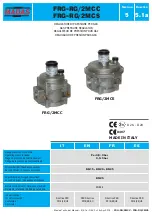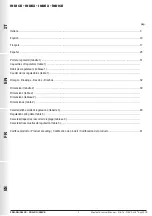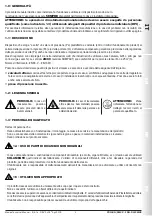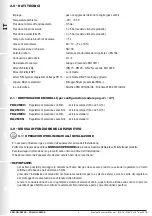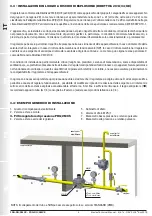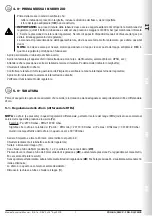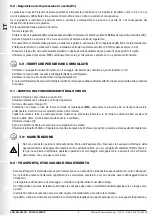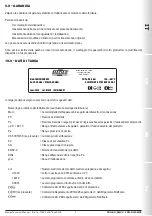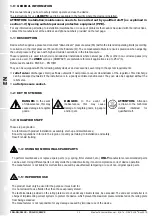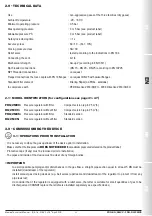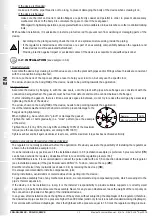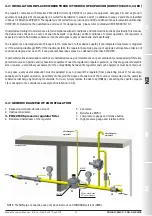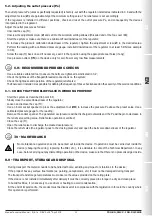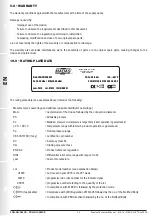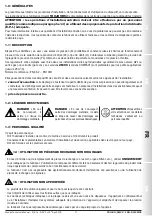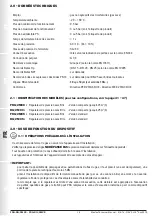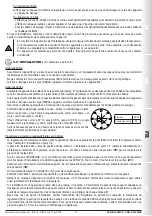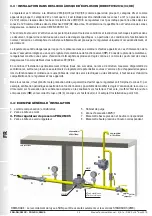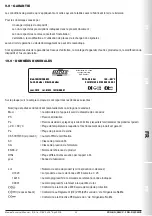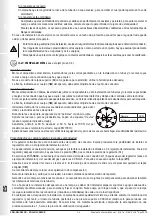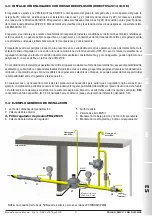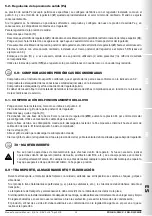
IT
EN
FR
ES
15
Madas Technical Manual
- 5|5.1a - REV. 0 of 5
th
Apr 2019
FRG-RG/2MCC - FRG-RG/2MCS
5.2 - Adjusting the outlet pressure (Pa)
The outlet pressure Pa (unless specifically requested) is factory-set with the regulator installed as indicated in 3.4 and with the
adjustment screw (
2
) set approximately at the minimum setting value. The relief valve is set accordingly.
If the regulator is installed in different positions, check and reset the outlet pressure Pa, and consequently the devices
incorporated in the regulator;
Adjust the outlet pressure as follows:
• Unscrew the cap (
1
);
• Unscrew the adjustment screw (
2
) and set it to the minimum setting allowed (threaded end of the top cover (
3
));
• Start the system or make sure there is a minimum flow downstream of the regulator;
• To increase the pressure calibration downstream of the regulator, tighten the adjustment screw (
2
) to the desired value.
Perform the reading with a calibrated pressure gauge, installed downstream of the regulator to at least 5 DN (see example
in 3.4);
• Screw the cap (
1
) back on and if necessary, seal it in that position using the appropriate seal holes (if any);
• Use pressure outlets (
15
) on the device only for zero flow or very low flow measurements.
6.0 - RECOMMENDED PERIODIC CHECKS
• Use a suitable calibrated tool to ensure the bolts are tightened as indicated in 3.2;
• Check the tightness of the flanged/threaded connections on the system;
• Check the tightness and operation of the regulator/relief valve;
The final user or installer is responsible for defining the frequency of these checks based on the severity of the service conditions.
6.1 - CHECK THAT THE RELIEF VALVE IS WORKING PROPERLY
• Start the system as described in point 4.0;
• Slowly close the valve downstream of the regulator;
• Loosen and remove the cap (
1
);
• Use an 8 mm socket spanner to press the adjustment nut (
20
) to increase the pressure Pa above the preset value. Use a
calibrated pressure gauge for the reading;
• Remove the socket spanner. The generated overpressure will be discharged outwards and the Pa will begin to decrease to
the relief valve setting value. Relief valve operation is verified;
• Close the cap (
1
);
• Open the relief valve to discharge the created overpressure;
• Close the relief valve (the regulator goes to the closing pressure) and open the ball valve downstream of the regulator.
7.0 - MAINTENANCE
• No maintenance operations need to be carried out inside the device. If operations must be carried out inside the
device (changing the spring, replacing the filter, etc.), it is advisable to contact the Technical Department. In any
case, before carrying out any dismantling operation on the device, make sure that there is no pressurised gas inside.
8.0 - TRANSPORT, STORAGE AND DISPOSAL
• During transport the material needs to be handled with care, avoiding any impact or vibrations to the device;
• If the product has any surface treatments (ex. painting, cataphoresis, etc) it must not be damaged during transport;
• The transport and storage temperatures must observe the values provided on the rating plate;
• If the device is not installed immediately after delivery it must be correctly placed in storage in a dry and clean place;
• In humid facilities, it is necessary to use driers or heating to avoid condensation;
• At the end of its service life, the product must be disposed of in compliance with the legislation in force in the country where
this operation is performed.

